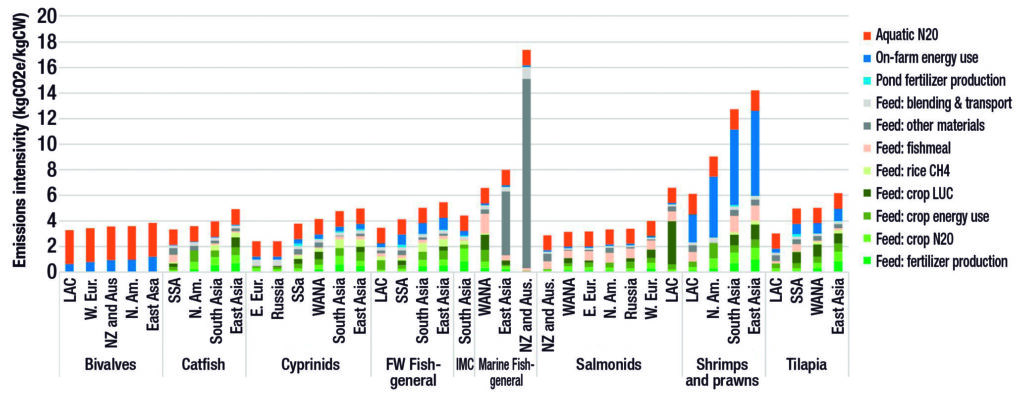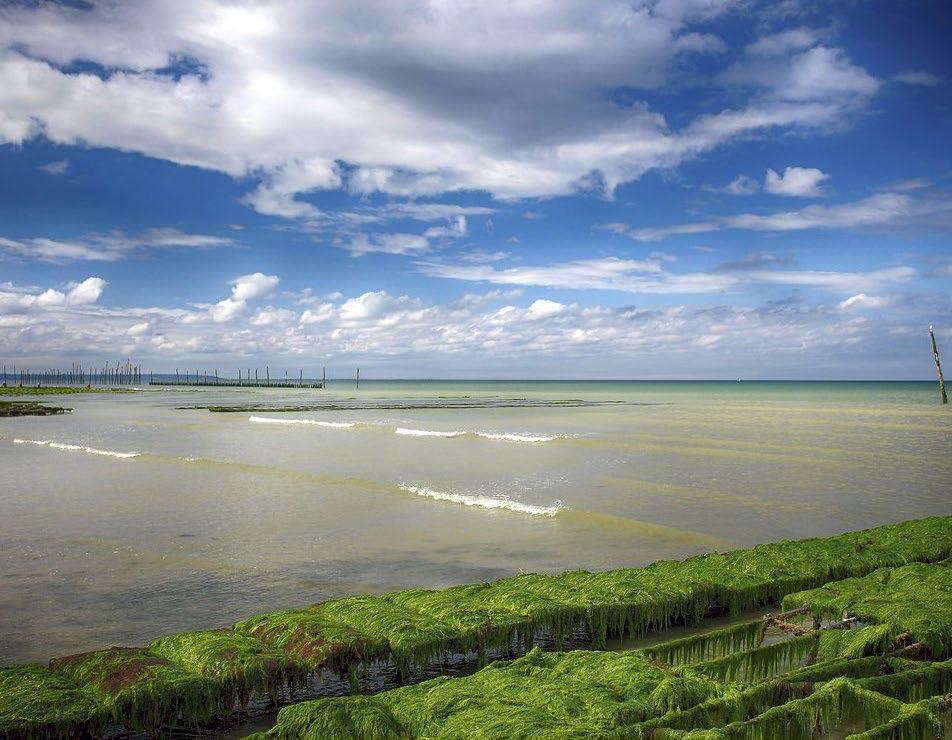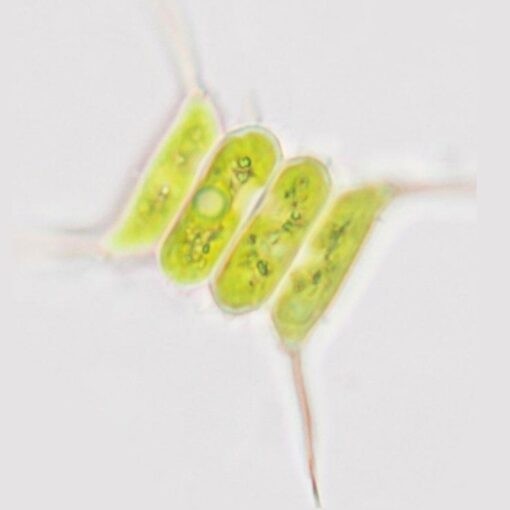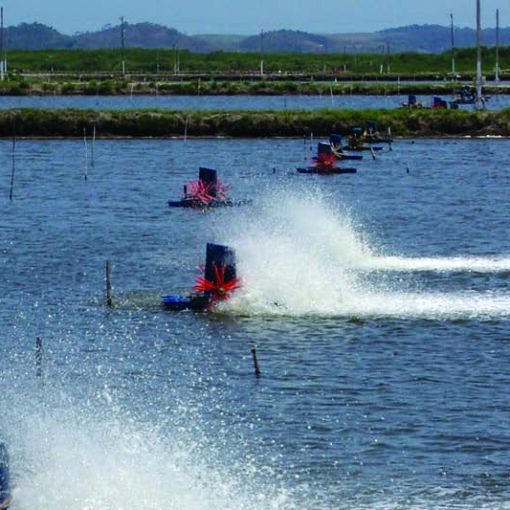Michael J. MacLeod, Mohammad R. Hasan, David H. F. Robb & Mohammad Mamun‑Ur‑Rashid*
This study developed by a international group of academics and researchers based on the UK, Italy and Bangladesh quantifies the global GHG emissions from aquaculture (excluding the farming of aquatic plants), with a focus on using modern, commercial feed formulations for the main species groups and geographic regions. In order to enable the sustainable expansion of aquaculture, we need to understand aquaculture’s contribution to global GHG emissions and how they can be mitigated.
Global aquaculture makes an important contribution to food security directly (by increasing food availability and accessibility) and indirectly (as a driver of economic development). In order to enable a sustainable expansion of aquaculture, we need to understand aquaculture’s contribution to global greenhouse gas (GHG) emissions and how it can be mitigated.
This study quantifies the global GHG emissions from aquaculture (excluding the farming of aquatic plants), with a focus on using modern, commercial feed formulations for the main species groups and geographic regions. Here we show that global aquaculture accounted for approximately 0.49% of anthropogenic GHG emissions in 2017, which is similar in magnitude to the emissions from sheep production.

The modest emissions reflect the low emissions intensity of aquaculture, compared to terrestrial livestock (in particular cattle, sheep and goats), which is due largely to the absence of enteric CH4 in aquaculture, combined with the high fertility and low feed conversion ratios of finfish and shellfish.
Animal aquaculture production has expanded since the 1980s (see Figure. 1) and it has been argued that the capacities for further expansion of marine aquaculture are theoretically huge.

In light of this, FAO concluded that as the sector further expands, intensifies and diversifies, it should recognize the relevant environmental and social concerns (e.g. competition for land and water, impacts arising from feed production, water pollution, antimicrobial resistance) and make conscious efforts to address them in a transparent manner, backed with scientific evidence.
One of the key environmental (and social) concerns is climate change, specifically the greenhouse gas (GHG) emissions that arise along food supply chains. To enable the sustainable expansion of aquaculture, we need to understand aquaculture’s contribution to global GHG emissions and how they can be mitigated.
Here, we apply a method (see Figure 4) for quantifying the GHG emissions arising from the culture of the main aquatic animals reared for human consumption, i.e.: bivalves, shrimps/prawns, and finfish (catfish, cyprinids, Indian major carps, salmonids, and tilapias).

The method quantifies the main GHG emissions arising “cradle to farm-gate”, from the following activities:
• the production of feed raw materials,
• processing and transport of feed materials,
• production of compound feed in feed mills and transport to the fish farm,
• rearing of fish in water.
We quantify the total GHG emissions from global aquaculture and compare these emissions with other livestock sectors. We also calculate the emissions intensity (i.e. the kg of GHG emissions per unit of edible output) of aquaculture and explain the factors that influence it.

Importantly, we have used recent commercial feed formulations for the main species groups and geographic regions, thereby providing a more up to date and detailed analysis than is generally provided in academic literature.
Results
Total emissions from global aquaculture
We calculated the GHG emissions for the year 2017 for the nine major aquaculture culture groups. The total GHG emissions for this 93% were 245 MtCO2e (see Table 1).

Assuming that the remaining 7% of production has the same emissions intensity (EI), the total emissions in 2017 for all shellfish and finfish aquaculture would be 263 MtCO2e. UNEP estimated total anthropogenic emissions to be 53.5GtCO2eq/year in 2017, so the culture of aquatic animals represented approximately 0.49% of total anthropogenic emissions (i.e. 263Mt/53.5Gt).
«The geographical pattern of emissions closely mirrors production, i.e. most of the emissions arise in the regions with the greatest production: East Asia and South Asia.»
Emissions also correlate closely with production for most species-groups, e.g. cyprinids account for 31% of emissions and 31% of production. However, there are exceptions to this: shrimp account for 21% of emissions but only 10% of production, while bivalves produce 7% of emissions but represent 21% of production.

Production of crop feed materials (the green segments of Fig. 2) accounted for 39% of total aquaculture emissions. When the emissions arising from fishmeal production, feed blending and transport are added, feed production accounts for 57% of emissions.
«The bulk of the non-feed emissions arise from the nitrification and denitrification of nitrogenous compounds in the aquatic system (“aquatic N2O”) and energy use on the fish farm (primarily for pumping water, lighting and powering vehicles).»
In order to compare aquaculture emissions with those arising from meat production, the aquaculture emissions for 2010 were calculated and compared with the emissions calculated for livestock by FAO using GLEAM.
The FAO data were used for comparison as they have the same scope and methods as the method used in this paper. 2010 was chosen as it is the most recent year for which FAO have reported global livestock results. The results of the comparison are presented in Figure 3.

This figure also includes the global emissions for capture fisheries though these are for 2011 rather than 2010. The global emissions from aquaculture are lower than livestock because
(a) there is a greater amount of livestock production (in 2010 fish and shellfish accounted for 6% of global protein intake, compared to 18% of protein from meat) and,
(b) overall livestock has higher emissions intensity than aquaculture.
Emissions intensity of aquaculture
The regional average EI of each species-group is shown in Fig. 2. For most of the finfish, the EI lies between 4 and 6 kgCO2e/ kg CW (carcass weight, i.e. per kg of edible flesh) at the farm gate.

The exception is the category “marine fishes, general”, which has a significantly higher EI, due to the assumption that the ration in East Asia (and New Zealand and Australia) is 100% lowvalue fish/trash fish (which has a higher EI than most crop feed materials) and the higher feed conversion ratio (FCR, i.e. the kg of feed input per unit of liveweight gain) of this species-group.
«Shrimps and prawns have high EI, due to the more significant amounts of energy used in these systems (primarily for water aeration and pumping). In contrast, bivalves have the lowest EI as they have no feed emissions, relying on natural food from their environment.»
Within the finfish, there are some differences in the sources of GHG emissions. Species predominantly reared in Asia (i.e. Indian major carps, freshwater catfishes and cyprinids) have higher rice methane emissions.
In comparison, the carnivorous salmonids have more emissions associated with fishmeal and higher crop land use change (LUC) emissions (arising from soybean production), reflecting their higher protein rations.

Comparing global averages, aquaculture has a much lower EI than ruminant meat and is similar to the main monogastric commodities (pig meat and broiler meat) (see Fig. 3).
It should be noted that there can be significant variation in the EI of commodities, depending on factors such as genetics, feeding, and farm management (for a discussion of the factors influencing the EI of ruminants and monogastrics).
«Fish (both finfish and shellfish) have lower EI than ruminants for three main reasons: they do not produce CH4 via enteric fermentation, they have much higher fertility (so the “breeding overhead” is therefore much lower) and they have lower feed conversion ratios (which are a key determinant of fish EI, given the predominance of feed related emissions).»
Fish generally have lower FCRs than terrestrial mammals, due to the latter’s higher maintenance and respiratory costs. Being buoyant and streamlined, fish require less energy for locomotion, they are coldblooded, and they excrete ammonia directly.
Discussion
Limitations of the analysis
The emissions are calculated for aquaculture of aquatic animals only. Therefore, they do not include the emissions arising from the production of aquatic plants, which constitute a significant proportion of global aquaculture production. The importance of feed is evident in Fig. 2 for all fed species.
«However, feed composition is continuously changing as nutritional knowledge and its application develops in response to commercial demand. This study was based on regional assumptions of feed formulations and raw material origins for the key regions’ main species.»
Data for this was obtained from various sources (see “Methods” in the original version of this article) and updated in light of discussions with feed companies.
Improved knowledge of feed formulation and raw material sourcing, combined with the overall feed efficiencies of conversion to edible seafood, will help provide a more accurate picture of the overall emissions. Ultimately this would have to be done with primary data from feed companies and farmers on a case by case level.

The analyses do not include losses and emissions occurring postfarm. Depending on the specifics of the post-farm supply chain (e.g. mode of transport, distance transported, mode of processing, storage conditions), significant emissions can arise from energy use in transportation or from refrigerant leakage in cold chains.
However, it should be noted that all GHG emissions are attributed to the aquaculture in this study, whereas, in practice, aquaculture produces processing by-products (such as trimmings) that are often used in other sectors, and the associated emissions should be allocated to these sectors.
«The estimates of aquatic N2O should be treated with caution, as the rate at which N is converted to N2O in aquatic systems can vary greatly, depending on the environmental conditions. It has been noted that many parameters are influenced by nitrification and denitrification processes (e.g. dissolved oxygen concentration, pH, and temperature).»
Finally, this study relies on data currently available in the literature. While the best available data has been used, we recommend that true empirical studies, involving primary data gathering on key parameters, should be undertaken to validate the results.
Reducing emissions from aquaculture
It has been argued that because the aquaculture sector is relatively young compared with terrestrial livestock sectors, it offers great scope for technical innovation to increase resource efficiency further.
They go on to identify four broad technological approaches to reducing the environmental impact of aquaculture:
(1) breeding and genetics,
(2) disease control,
(3) nutrition and feeding, and
(4) low-impact production systems.
Within each of these approaches are many individual measures that could be used to reduce (or mitigate) GHG emissions.
There are many ways of reducing emissions from crop production that could be employed to minimize aquaculture feed emissions. Other measures could target the efficiency of feeding. Aquaculture nutrition is arguably more complicated than terrestrial livestock production, in the sense that it has many more species being farmed.

In theory, each species has different nutritional requirements, although the information to provide this accurately is often lacking. This drives relatively poor use of nutrients as the focus is on providing certain raw materials that mimic what is consumed in the wild—for example feeding high inclusions of fishmeal to some carnivorous species, in particular marine fishes.
The opportunity to optimize nutrition is probably greater in aquaculture than in terrestrial species, since much greater research effort has been focused on terrestrial species to date. Some mitigation measures may be quite expensive, while others are relatively cheap or may even reduce costs.
To achieve the twin goals of reducing emissions while increasing the supply of affordable protein, we need to analyze the effects that introducing measures may have onfarm profits and emissions. Cost-effectiveness analysis (CEA) can help us to understand these effects.
Conclusions
Aquaculture is a biologically efficient way of producing animal protein compared to terrestrial livestock (particularly ruminants) due largely to the high fertility and low feed conversion ratios of fish. The biological efficiency is reflected in the relatively low prices and emissions intensities of many aquaculture commodities.
However, the moderate GHG emissions from aquaculture should not be grounds for complacency. Aquaculture production is increasing rapidly, an emissions arising post-farm, which are not included in this study, could significantly increase the emissions intensity of some supply chains.
Furthermore, aquaculture can have important non-GHG impacts on, for example, water quality and marine biodiversity. Therefore, it is important to continue to improve the efficiency of global aquaculture to offset increases in production so that it can continue to make an important contribution to food security.

Fortunately, the relatively immature nature of the sector (compared to agriculture) means that there is great scope to improve resource efficiency through technical innovation, often in ways that reduce emissions while improving profitability.
CEA can help identify the most cost-effective efficiency improvements, thereby supporting the sustainable development of aquaculture.
*This article is licensed under a Creative Commons Attribution 4.0 International.
It was originally published on july 2020 through the Nature Scientific Reports Online Journal.
The original version can be accessed at: https://www.nature.com/articles/s41598-020-68231-8
Correspondence author:
email: michael.macleod@sruc.ac.uk







